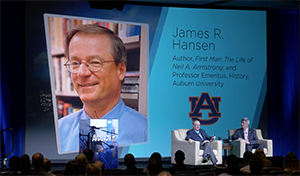How Aeronautics Built the Foundation for Apollo’s Legacy Written 21 June 2019
by Michele McDonald, AIAA Communications Manager

AIAA AVIATION FORUM, Dallas, June 21, 2019 — Never again in aerospace will one crucial group driven by their passion for aeronautics have such influence on the direction of the space mission, historians James Hansen and Bill Barry told the “Apollo’s Legacy and Impact on Modern Flight” plenary audience.
Barry, NASA’s chief historian, and Hansen, an Auburn University professor emeritus who is best known for the Neil Armstrong-authorized biography “First Man,” turned the conversation upside down to look at how aeronautics affected the Apollo mission and astronautics.
Aeronautics and astronautics quickly became separate fields, and that split is still playing out today, Barry noted.
“You really can’t understand the space program [without knowing about the influence of aerospace],” he said.
Hansen agreed.
“Aeronautics really might be called the ‘other NASA,’” he said, adding that “air-minded” whose true passion was aeronautics were none too happy about the rise of space.
But without aeronautics, the American human spaceflight program would not have taken off, Hansen said.
The world owes a debt to the transformative technology that came out of the Apollo mission. Modern microchips descended from the integrated circuits used in the Apollo Guidance Computer. Dave Scott used the “lunar module rotational hand controller,” or joystick, to fly to the lunar surface on Apollo 15’s Lunar Module Falcon.
Another technical achievement is digital fly-by-wire, which was developed for the small and reliable electronic computers used for the Apollo Lunar Module.
